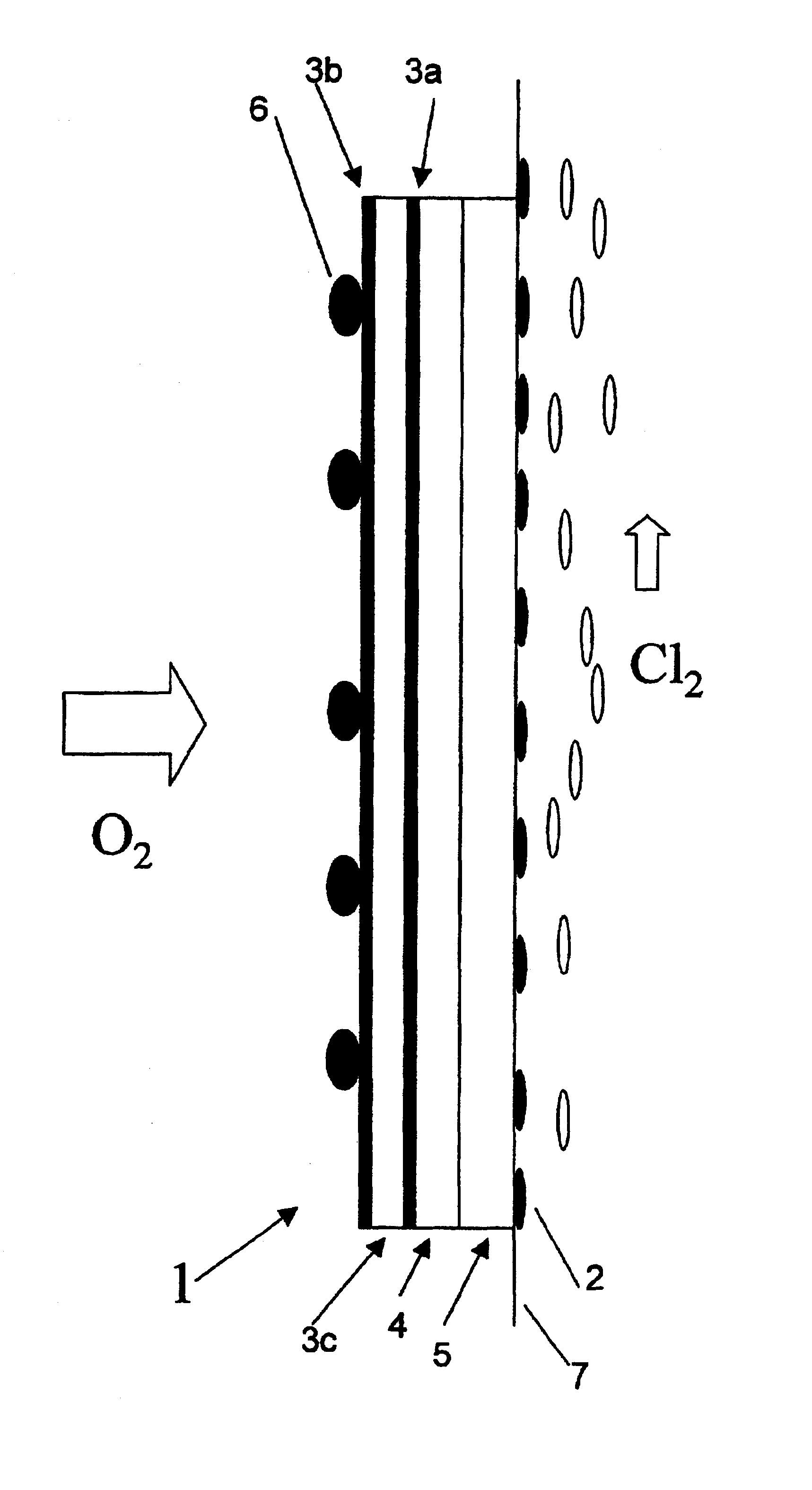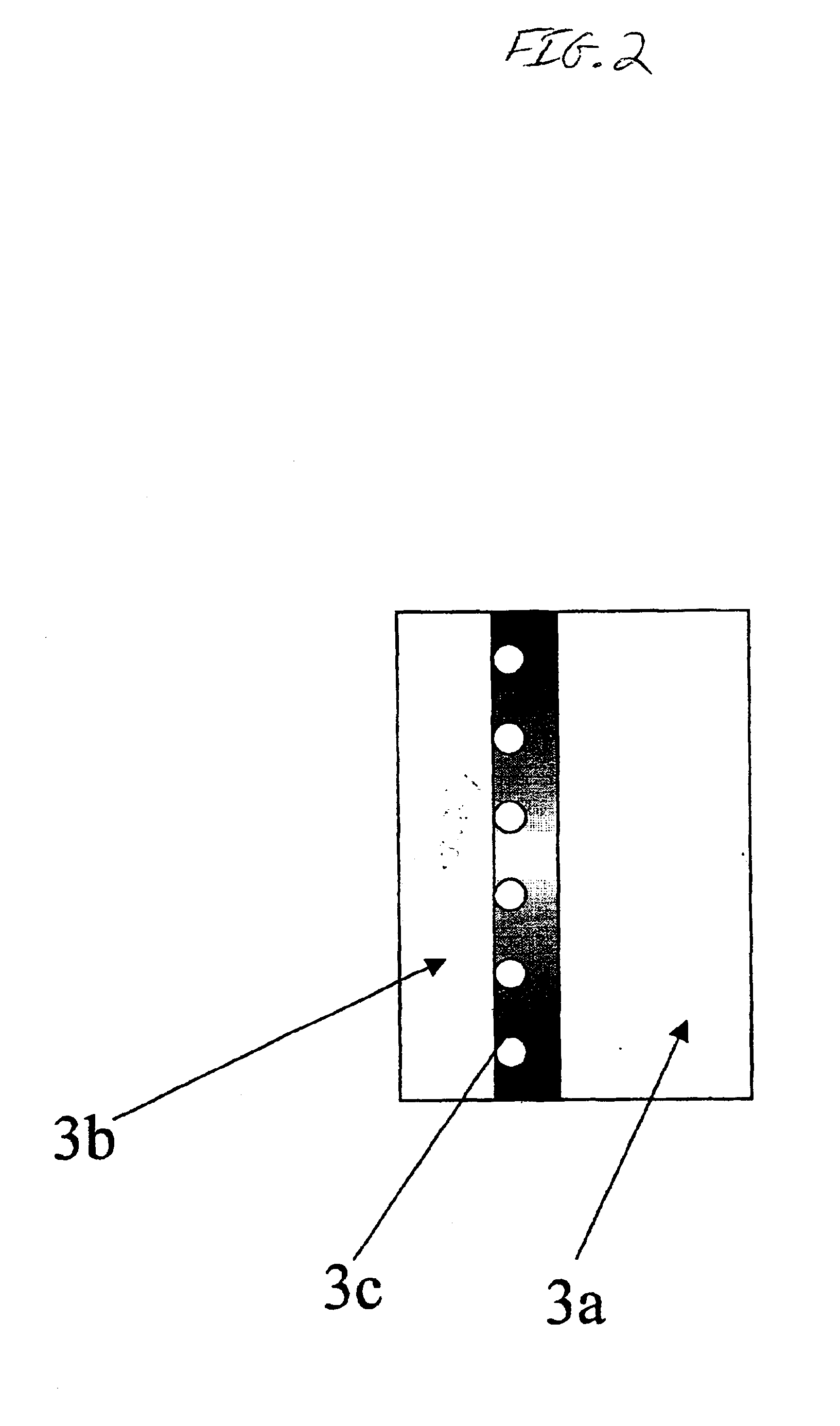Electrode
a technology of electrodes and electrodes, applied in the field of electrodes, can solve the problems of electrolysis reaction, containing gas supplied, and having a theoretical cell voltage of 2.24 v, and achieve the effects of preventing unwanted oxidation processes, preventing any substantial fluctuation in cell voltage or current density, and ensuring stable operation of the electrolytic cell
- Summary
- Abstract
- Description
- Claims
- Application Information
AI Technical Summary
Benefits of technology
Problems solved by technology
Method used
Image
Examples
example 1
A 0.3 mm thick expanded silver mesh was prepared from a 0.1 mm thick silver plate, which was used as electrode substrate in a gas diffusion electrode. The gas diffusion electrode was subsequently manufactured in the following way:
1) A silver powder paste solution consisting of particles ranging from 0.5-1 .mu.m was spread over a silver mesh, which was subsequently dried.
2) Following drying, the electrode substrate was sintered in air at a temperature of 450.degree. C. for 30 minutes.
3) Dinitro diammine platinum salt dissolved in an alcohol solution, containing 50 g Pt / liter, was subsequently applied to one side of the prepared electrode substrate and baked at 350.degree. C. in nitrogen gas atmosphere for 10 minutes, thereby forming a platinum-coated gas diffusion electrode.
4) 2-propyl tetrabuthoxi zirconium, i.e. Zr(C.sub.3 H.sub.5 O).sub.4 solution, was applied to the same substrate side as the platinum solution, whereafter the electrode was baked at 450.degree. C. for 10 minutes. ...
example 3
The gas diffusion electrode was made as in example 1. On the front surface of the reaction layer, a graphite carbon cloth available from Toho Rayon Company Limited was soaked in the zirconium dioxide solution of example 1 and attached to the gas diffusion electrode with the ZrO.sub.2 side facing the reaction layer. The formed electrode was subsequently dried at 250.degree. C. for 3 hours. The electrode was then heated to 450.degree. C. in an oven for 30 minutes. Following heat treatment, the electrode was cooled to 25.degree. C., PTFE solution was subsequently applied to the back surface of the gas diffusion electrode and baked at 250.degree. C. for 30 minutes. A gas diffusion electrode having a porous hydrophilic layer was thereby obtained. The obtained gas diffusion electrode was submitted to the same electrolysis test as in example 1. The results showed a cell voltage of 2.02-2.05 V at a current density of 40 A / dm.sup.2 at 90.degree. C. No deterioration in electrolysis was observ...
example 4
The expanded silver mesh of example 1 was used to manufacture a gas diffusion electrode. Silver paste comprising silver powder as of example 1, 20% PTFE (30 NE available from Dupont) was applied on the mesh to make it porous. On one side of the plate, an additional amount of 20% PTFE was applied. The obtained electrode was dried and heated to 200.degree. C. for 10 minutes. It was subsequently pressed at 5 kg / cm.sup.2 at 150.degree. C. for 10 minutes. The electrode of the gas diffusion electrode was then coated with a hexachloro platinate 2-propyl alcohol solution on the opposite side of the PTFE side and subsequently heated at 300.degree. C. for 30 minutes. A 90 wt % ZrO.sub.2 paste comprising 10-20 .mu.m ZrO.sub.2 particles and 10 wt % PTFE (30 NE available from Dupont) were applied on the platinum side of the reaction layer followed by heating at 300.degree. C. in air for 15 minutes. The obtained gas diffusion electrode was submitted to the electrolysis test under the same conditi...
PUM
| Property | Measurement | Unit |
|---|---|---|
| cell voltage | aaaaa | aaaaa |
| cell voltage | aaaaa | aaaaa |
| temperature | aaaaa | aaaaa |
Abstract
Description
Claims
Application Information
 Login to View More
Login to View More - R&D
- Intellectual Property
- Life Sciences
- Materials
- Tech Scout
- Unparalleled Data Quality
- Higher Quality Content
- 60% Fewer Hallucinations
Browse by: Latest US Patents, China's latest patents, Technical Efficacy Thesaurus, Application Domain, Technology Topic, Popular Technical Reports.
© 2025 PatSnap. All rights reserved.Legal|Privacy policy|Modern Slavery Act Transparency Statement|Sitemap|About US| Contact US: help@patsnap.com



